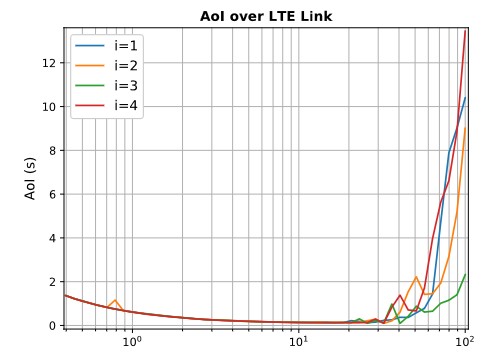Age-of-Information in practice: Status age measured over TCP/IP connections through WiFi, Ethernet and LTE
This work presents one of the first real-world demonstrations of Age of Information (AoI) measurements conducted over practical TCP/IP-based communication links. While the vast majority of AoI research has been theoretical—relying on idealized queuing models and assumptions about network behavior—this study bridges the gap between theory and practice by measuring the status age over actual WiFi, Ethernet, LTE, 3G, and 2G networks, using both network emulation and physical deployments.

AoI, which quantifies the freshness of information at the receiver, has become a key performance indicator for time-sensitive applications such as remote monitoring, industrial automation, and real-time control. This study investigates the complex interplay between sampling rates, transport-layer queuing, and link-layer characteristics in determining the practical performance of AoI over commonly used network technologies.
In the emulation setup, a network testbed using the CORE emulator was constructed to model various network configurations under TCP/IP. This setup revealed that AoI exhibits a non-monotonic relationship with sampling rate—a phenomenon that had previously only been predicted in theoretical models. When sampling rates are increased beyond a threshold, network buffers become saturated, leading to delayed packet deliveries and stale updates.
Complementing the emulation, real-world experiments were conducted using a distributed client-server architecture. The client, connected to different access technologies (WiFi, Ethernet, LTE, 3G, 2G), generated status updates at various rates and transmitted them to a server located in France. A custom time-synchronization mechanism was developed to accurately measure age over the Internet. The experimental results confirmed the non-linear behavior of AoI observed in emulations, and further illustrated how bandwidth limitations, queuing delays, and access technology properties shape the evolution of status age in practice.

Key observations include:
-
AoI initially decreases with increased sampling rate due to more frequent updates.
-
Beyond an optimal point, AoI increases again due to buffering and queuing delays, especially in bandwidth-constrained networks like 2G and 3G.
-
The optimal sampling rate for minimal AoI varies significantly across access technologies.
This study demonstrates that minimizing AoI in real-world networks is not as straightforward as maximizing update rates. Instead, intelligent update scheduling strategies that adapt to network conditions are needed to prevent congestion and staleness.
By offering the first measurements of AoI over actual TCP/IP cellular and broadband connections, this work lays the foundation for developing practical, AoI-aware communication protocols and system architectures. It provides valuable insights for both researchers and engineers designing latency-sensitive, freshness-critical IoT and MTC systems operating over heterogeneous networks.

